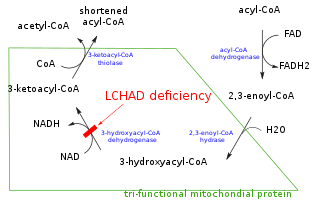| 2-methylacyl-CoA dehydrogenase | |||||||||
|---|---|---|---|---|---|---|---|---|---|
| Identifiers | |||||||||
| EC no. | 1.3.99.12 | ||||||||
| CAS no. | 85130-32-1 | ||||||||
| Databases | |||||||||
| IntEnz | IntEnz view | ||||||||
| BRENDA | BRENDA entry | ||||||||
| ExPASy | NiceZyme view | ||||||||
| KEGG | KEGG entry | ||||||||
| MetaCyc | metabolic pathway | ||||||||
| PRIAM | profile | ||||||||
| PDB structures | RCSB PDB PDBe PDBsum | ||||||||
| Gene Ontology | AmiGO / QuickGO | ||||||||
| |||||||||
In enzymology, a 2-methylacyl-CoA dehydrogenase (EC 1.3.99.12) is an enzyme that catalyzes the chemical reaction
- 2-methylbutanoyl-CoA + acceptor 2-methylbut-2-enoyl-CoA + reduced acceptor
Thus, the two substrates of this enzyme are 2-methylbutanoyl-CoA and acceptor, whereas its two products are 2-methylbut-2-enoyl-CoA and reduced acceptor.
This enzyme belongs to the family of oxidoreductases, specifically those acting on the CH-CH group of donor with other acceptors. The systematic name of this enzyme class is 2-methylbutanoyl-CoA:acceptor oxidoreductase. Other names in common use include branched-chain acyl-CoA dehydrogenase, 2-methyl branched chain acyl-CoA dehydrogenase, and 2-methylbutanoyl-CoA:(acceptor) oxidoreductase. This enzyme participates in valine, leucine and isoleucine degradation.





